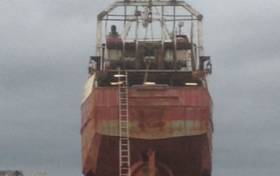Displaying items by tag: Excursion boat
Passenger Boat Heads to Howth for Overhaul Prior to Seasonal Cruises
#Boatyard – The latest customer at Howth Boatyard, Co. Dublin is a 120 passenger excursion boat that operates cruises from the harbour to Ireland’s Eye just offshore and around Dublin Bay, writes Jehan Ashmore.
The boat St. Bridget operates for Dublin Bay Cruises had departed Grand Canal Dock Basin yesterday having taken a winter lay-up berth. Before the steel-hulled vessel headed for the boatyard for routine maintenance overhaul, St. Bridget berthed in the Dublin city centre. This is from where seasonal cruises offering panoramic views of the bay begin in April linking Howth and Dun Laoghaire harbours.
St. Bridget has also over the years while off service in the winter taken a berth in Dun Laoghaire Harbour. This has been at the berth adjacent to where HSS Stena Explorer used alongside St. Micheals Wharf until the fastferry service to Holyhead, Wales closed operations in Autumn of 2014.
Since then Dun Laoghaire Harbour has been left with this sole passenger commercial service, albeit for domestic excursion purposes. In addition the former Aran Islands serving 25m long ferry also offers evening cruises to Killiney Bay.
Another vessel of a similar length at Howth Boatyard last week was a UK flagged highspeed craft crew transfer boat, MSC Kraver. The 167 gross tonnage craft had sailed from Birkenhead.
Earlier this month, Wicklow based tug workboat Husky had too availed of the yard’s 600 tonnes ‘Syncrolift’ facility. This sees boats raised out of the water and taken across to the boatyard set back from the quayside on the West Pier.





























































